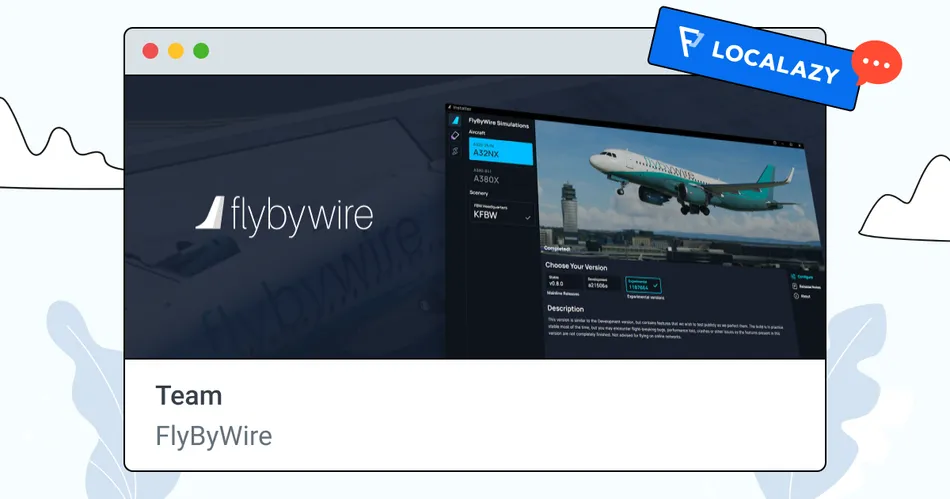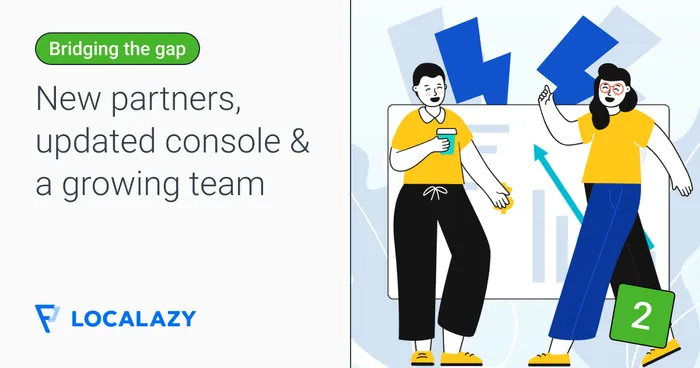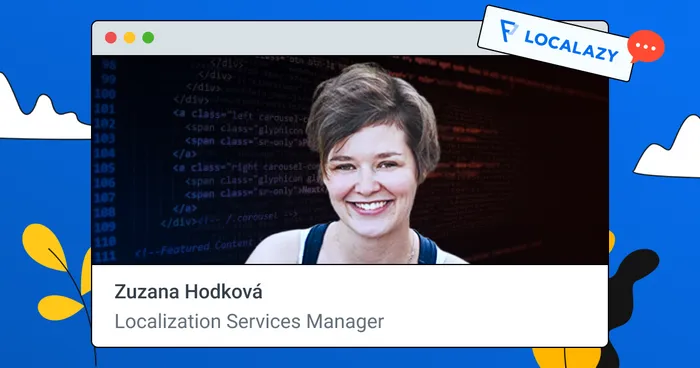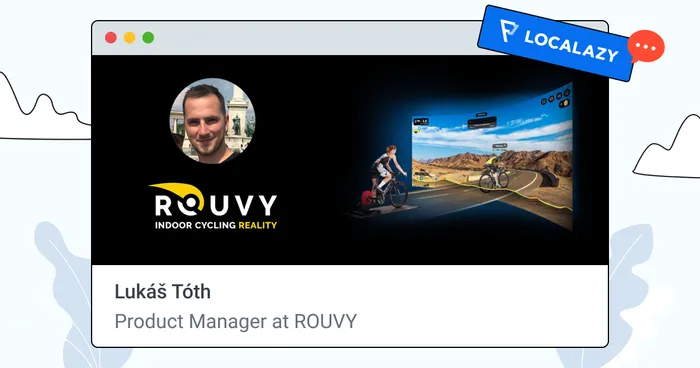If you've ever flown, chances are you've probably boarded an Airbus A320 at some point. It's one of the most popular aircraft, chosen by many airlines around the world for their commercial routes. If you haven't explored an A320, there's still hope: You can experience it anyway thanks to FlyByWire. But this time from their virtual cockpit, where flight simulation enthusiasts and real-life certified pilots gather around the joystick to experience an immersive flight simulation.
Since 2020, thousands have joined their Discord 👾 to improve the aircraft, support users, and share their knowledge. With over 600 live flights, 4000+ commits, and more than a million downloads, this popular project for Microsoft Flight Simulator has now implemented Localazy onto their flyPad.
Today, we analyze how they added 33 languages to the tablet with the help of their own community. This time, we decided to make it a double feature - meet Valastiri from marketing and Mav, business specialist by day and developer and tester by choice. Both have let us into the flight-sim community to talk about game localization, developing simulation solutions, and fostering a spirit of collaboration online. Time to board! 🧳 🛩️
✈️ What is FlyByWire? 🔗
Hey, guys! Stoked to have you here. What is FBW's vision?
Valastiri: FlyByWire Simulations is a community-driven open-source organization dedicated to creating realistic simulations of the Airbus A320neo and A380 for Microsoft Flight Simulator 2020. Our vision is driven by the concept of removing expensive barriers of entry to high-fidelity and realistic aircraft simulations by providing the same experience (or better) to aviation enthusiasts for free.
Mav: Exactly. Microsoft's idea is amazingly visually great and also aspires to be as realistic physically as possible. However, when they delivered the Airbus A320 model, it was very shallow in terms of technical depth and realness, so a part of our team started to improve the aircraft that came with the software. 🧑💻 At some point later, we actually created a separate aircraft simulation for everyone to enjoy.
Fascinating! Where does the term "fly-by-wire" actually come from?
M: It is actually a technology used by Airbus and other manufacturers to control the aircraft. The aircraft has a horn from which you can steer it. In Airbus' aircrafts it is usually a stick that looks like a joystick. Traditional joke-controlled aircrafts have cables to the control surfaces, so the cable is basically pulling the flight controls. Fly-by-wire does that electrically: you really have a joystick in the cockpit, but the aircraft steers those controls by other means, just not by cables. So this is what the term means: an aviation manufacturing technology that uses the joystick to steer the aircraft.
How did you personally get involved with the project? And what is your role within it?
V: I originally joined the team in 2020 as a graphics designer working on creating various media for our social media platforms to help establish branding norms. Since then, our media team has worked on rebranding into our established visuals that you see today. I currently wear multiple hats within the organization as a core team member, serving functions as a moderator on our Discord and primarily assisting in managing our media team functions. I also spend a significant amount of time ensuring our documentation is up-to-date alongside our Stable Version releases, authoring some of our blog posts through our NOTAMs series, and providing community support on our Discord.
"Our vision is driven by the concept of removing expensive barriers of entry to high fidelity and realistic aircraft simulations by providing the same experience -or better- to aviation enthusiasts for free"
M: There's a broad range of backgrounds involved in the project. I'm a computer scientist, but I only do programming as a hobby. My professional life is more about the business. I actually started doing flight simulation in 2020, when the new MFS came out. I found the project, and I started learning to operate an Airbus A320, and then I thought I'd help the community.
We connect via Discord, where we have a huge server with currently 80,000 users. 🤝 At that time, it was probably about 30,000 or 40,000 or even less, but it already was the main source for people to get help. I started helping in the support channels and writing documentation (60-70% I've written myself), and now we have a bigger team. After that, I also started developing part of the aircraft.
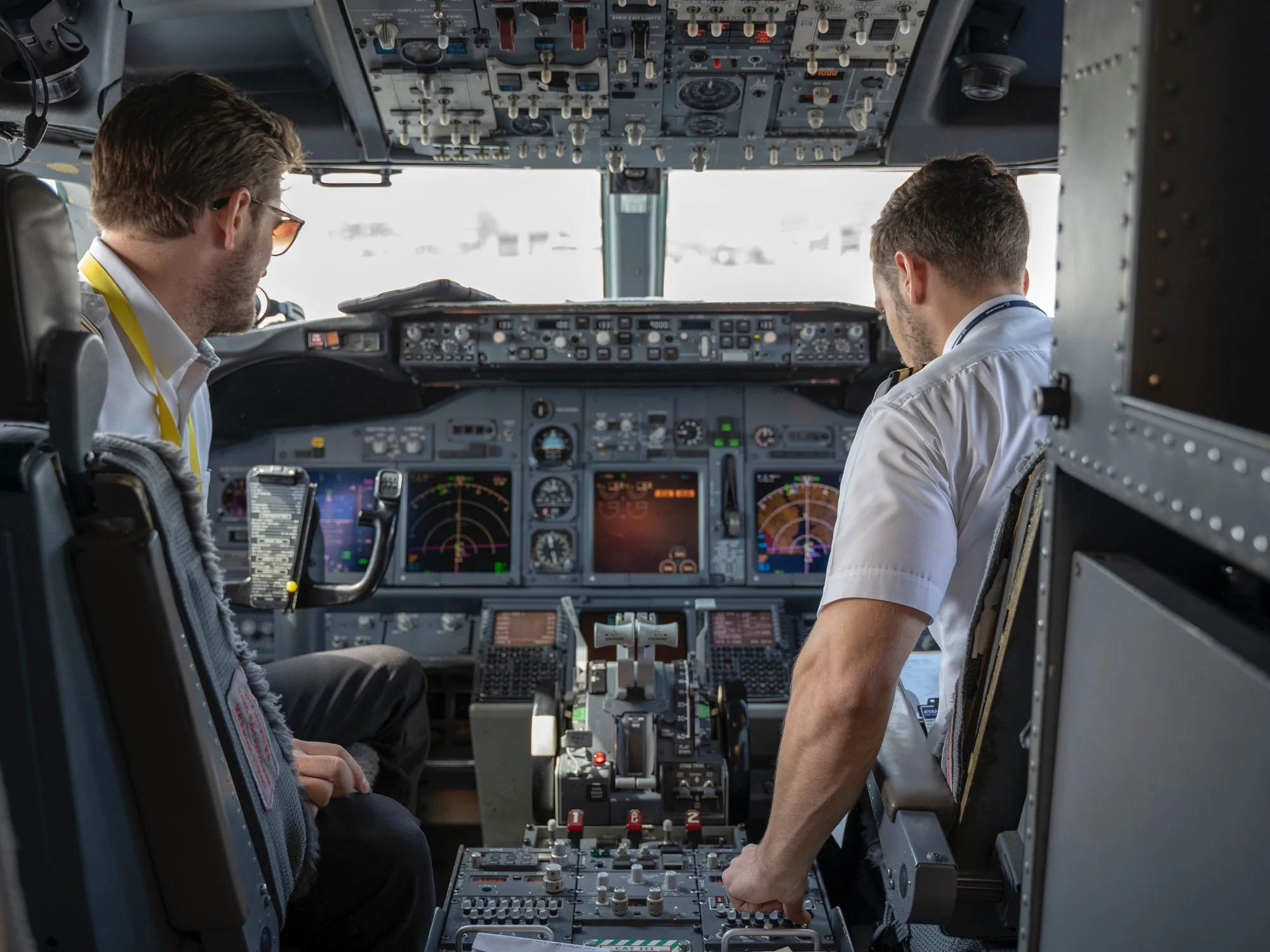
🧑✈️ Nurturing Community 🔗
FlyByWire is essentially a community project. How does that work, and what is the weight of that community in the project?
M: It is a not-for-profit community. The core team is about 20-30 people, and not a full-time endeavor. This is a hobby for us.
V: We do have a "core" team of developers, admin, moderators, and media team members that help steer and manage various aspects of our numerous projects. But FlyByWire's volunteer community contributors, now over 130 and growing, have been integral to our success over the years in developing all manners of realistic simulation of systems and flight in our A32NX product. Without them, we would be hard-pressed to be where we are today.
In the case of Localazy, it has allowed us to provide an onboard 🔌 electronic flight bag (EFB) that is usable in over 20+ languages through our flyPad. Volunteers from around the world have been able to submit their translations and seamlessly integrate them into our aircraft for all of our users to enjoy.
What are the biggest risks & challenges of working with volunteers?
V: One of our biggest risks is probably having a core member or contributor step away. We'd lose some of the expertise and knowledge each member offers, and it could potentially lead to feature implementation stalling. The great part of being open-source is that anyone interested is able to fill in the gaps and that everyone is welcome back at any time!
Can you elaborate a bit on your funding? 💸
V: We are primarily funded by donations through our Open Collective. We take any amount of one-time donations and monthly recurring as well. While no team member is paid through this fund, it allows us to ensure costs are covered for the content distribution network (CDN) 🔀 to serve our aircraft through the FBW installer. The fund also allows us to cover costs for attending expos, any hardware-specific or software-specific purchases the team could use if required, and incidental expenses related to development.
M: Yes, we mainly need funding for the servers - we spend about $1,000 USD a month on them because we have so many people that download the aircraft. It's more than 2GB, and everyone downloading it uses a lot of bandwidth. Fortunately, we have a great community in Open Collective 🤗 that sponsors us through donations from $5 on. We even have one donor who actually spent several thousand dollars a month to fund our project; kind of a super fan!
V: Also, Open Collective lets any user review what we've spent the donations on at any time and see our projected costs for the year to continue serving our products.
Make a donation to support FlyByWire here. ✈️ 💰
What is the most challenging part about promoting a community-funded project? What do the marketing efforts look like?
V: Two words. Organic growth. Marketing budgets can run wild, and so we have always relied on the success of the A32NX in its space and the following it has generated organically. We are also always grateful for the external coverage from various flight simulation news outlets and podcasts and for participating in interviews such as this one.
Our media team being volunteers, including myself, leads to the second biggest challenge – coordination. 🔄 Keeping our community engaged and aware of various project statuses is critical, while also promoting the hard work that all of our contributors develop for our projects.
🕹️ Innovation & Realism 🔗
You're expanding the universe provided by Microsoft Flight Simulator. In which fields are you innovating?
V: Our commitment to a realistic simulation of an A320neo is the focal point that sets us apart. We cater to the specific demographic of end-users who want an aircraft that does exactly what the real one would do. Our documentation 📝 and the flight school channel 🧑🏫 on our Discord server provide great learning tools and even allow beginner pilots to learn the complexities of operating a multi-million dollar aircraft.
Without constraints due to budgets or deadlines, we are free to really complete a feature that truly matches what would be seen in a real aircraft. Everything we have built based on the aircraft configuration we are targeting ensures that its functionality is matched as a real type-rated pilot would expect it, even down to the lesser-known quirks of the flight management system that may seem like bugs.
"We have a lot of real feedback from real pilots in our team that our aircraft feels real in the simulation. And if anything is wrong, we immediately get alerted. They're valuable assets to our community"
Certified pilots use FlyByWire to train. Can you talk us through the real-life applications that your simulator has?
V: We advocate that our aircraft is for simulation use only. We do aim for proper 1:1 simulation of systems; however, our product doesn't replace what proper training and education from accredited facilities would provide.
M: Having said that, we are lucky to have a lot of pilots in the community, even within the team. When we started the whole project during COVID-19, a lot of them had been laid off or had been on furlough at home. But if you are a 👩✈️ A320 Type Rating pilot, you have to go through an examination at least once a year to keep your license. They couldn't go into the real simulators, they couldn't fly, so what did they do? They started using MFS and "hopped" on our aircraft to just train and keep up to date. So we have a lot of real feedback from real pilots in our team that our aircraft feels real in the simulation. And if anything is wrong, we immediately get alerted. They're valuable assets to our community.
Additionally, if they want to be visible as pilots on our server, we expect that they offer proof of their certification. After that, they get a special role and a special color, so everybody knows this is a pilot, and they can rely on their knowledge. 👌
🪁 Localization: an experience enhancer 🔗
How did you decide to implement Localazy?
M: It came into play with our tablet. In the aircraft world, every pilot has one where they have special programs for planning the routes, calculating take-off and landing, altitude, direction... and many other applications. In the simulation, our FlyPad allows us to help users to control and configure it. You can, for example, import flight plans or settings for the aircraft. Our motto is "Everything needs to be 100% realistic". But the tablet? This is where we have freedom because it's different from airline to airline anyway.
So, you created your own interface.
M: Exactly. The flyPad is built from the ground up. We've spent a lot of time developing it. ➡️ ⚙️ There's a menu with settings where you can control how to talk to air traffic control as a part of the simulation. You can calculate things like landing, descending, etc. The FlyPad is quite popular within the community: we've invested a lot of time in its look and feel, and when we worked on the third version, we decided to have translations as well. We don't do multiple languages anywhere else in the aircraft, where English is always the language of choice.
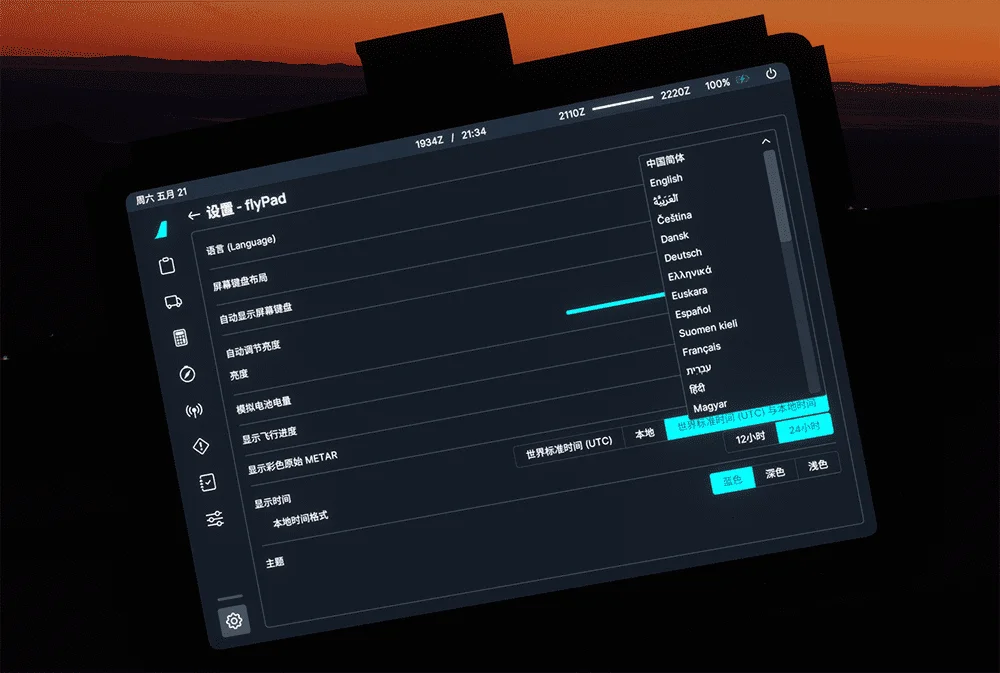
Why did you choose Localazy for this specific feature?
M: I was the one who implemented it later on, although I didn't choose it. The person who started to look into it, Erick, is currently not active because he's busy in real life, as we say; but he really liked Localazy and found it really easy to use. He tried a small prototype to see how that looked, and we liked it, so we started implementing it into the product and got a subscription that we also paid, thanks to our donations. Then, we really started to extend the whole process.
Compare and find the Localazy plan that best fits your needs!
How many languages have you tackled yet?
M: The flyPad has currently over 30 languages. We had the whole thing translated in a matter of weeks! 🏃 We did a little marketing around it so the community could help, and they loved to support us. If your users love your product, it is actually very easy to have it localized.
What is your favorite feature? And what could be improved or added?
M: We love the ease of use. That we could just share a link here, create an account there, and... basically start translating. We didn't have to test it for long because we really liked your interface. It simply worked! 😀 We have included the Localazy API in our build process so that we can get the latest approved translations every time we build our product.
What do you think about our autopilot and machine learning features?
M: Oh, I love them. One of the features I desperately wanted to try was DeepL because I use it a lot in my job, and it's probably the best translation tool - especially for German, as it's quite accurate. It also works very well for localizing, so I was happy to have access to it.
I also like the review feature a lot because if I'm reviewing a language I don't speak (as we can't always use dedicated reviewers in all languages), the reverse translation helps us a lot.
Why do you think localization is important?
M: There are two main benefits for us: one is the operative one. If you have a non-standard tablet in aviation, it's good to have it in other languages so that non-native speakers say, in Russia, have an easier time using it. The other reason is community inclusion. When you're not part of one of these communities, it's hard to express how people love to contribute to the project. Translation was really one of the features they loved, and we got a lot of feedback from them. Although it's calmed down now because it's working, in the beginning, the interaction with the community because of localization was amazing.
"If your users love your product, it is actually very easy to have it localized"
Aside from Localazy, what are other products you really like to use on your own and that you recommend?
M: In the flight simulation area, there's actually a huge industry around building simulation hardware, like artificial cockpit parts that you can put on your desk, or software that feeds real-life air traffic into the simulator,. There are a few ones I'd recommend. I love SPAD.neXt, as it helps me connect all kinds of hardware to the simulator, like my Thurstmaster Airbus controller or my Elgato Stream Deck.
As for software development tools, I really like:
- The coding tools from JetBrains 🔧
- The co-pilot feature on GitHub 🤖
🛩️ The future of flight simulators 🔗
Any exciting feature you're working on as of now?
V: We have a few great features coming to the A32NX that expand upon the functionality of the flight management system. Our largest endeavor currently is our A380X, our upcoming aircraft based on the Airbus A380 "Queen of the Skies."
M: The community is crazy about it! 🤩 It's a two-story plane, the biggest in the world. There's no other simulation for it, so we would be the first to do it. We've been working on it for over two years, and it's a huge project. We have a nice model, and we're now working on details like the system. We'll have the same tablet, but it will probably be extended, which means that we'll go back to Localazy for that.
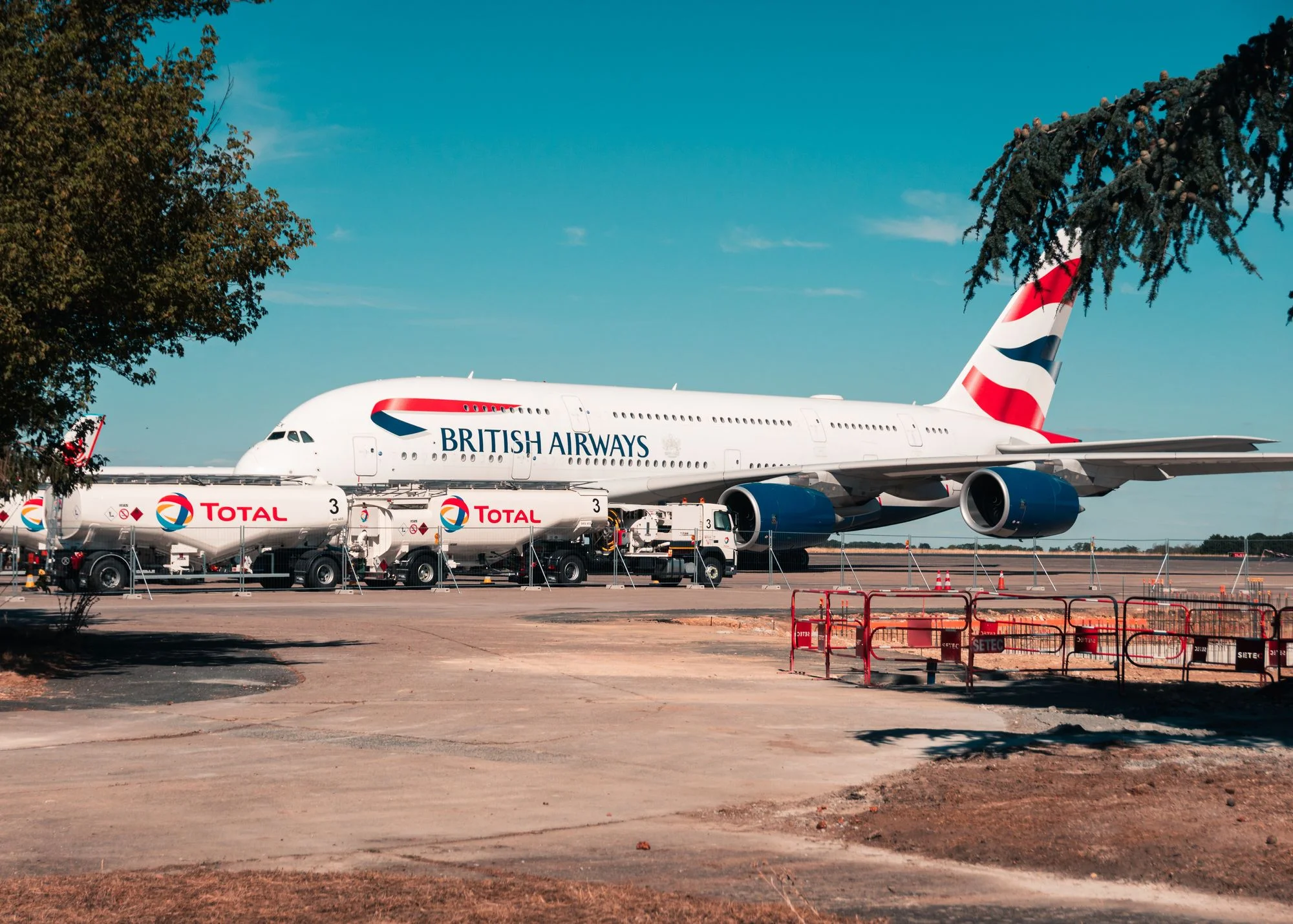
One project I'm also working on related to Localazy is 🖲️ button descriptors (tool tips), a feature that is present in MFS. When you use your mouse and hover it over a button or switch, then you get a description tool that professional pilots aren't interested in, but that flight simmers that use the simulation as a game like, as they need to understand what every button does and how do they use it. These tool tips are something I see possible to implement now with Localazy as well, so you can configure the flight simulator to be, for example, in Spanish and then have all the tools in Spanish as well. Plus, we recently released the vertical navigation feature to the community, and they're super happy with it.
And what do you think – how will the gaming and simulation industry look like in about ten years from now?
M: It will get even more realistic with time. One problem right now for many of our users is still the ability of their PCs to process the simulation. For example, if you have MFS 2020 right now with full settings, you need an expensive graphics card, an expensive CPU, or, simply put, an expensive computer. But if you have the power, it's incredibly realistic. In a few years' time, a flight simmer will basically be able to be completely immersed in that experience.
With all the AI buzz, I also think developer work will evolve. In 10 to 20 years, the main work of a developer will be to understand business problems: find the real issue and then tell the AI what you need in terms of code - this has already started with tools like GitHub Co-Pilot, which suggests full code blocks while you are typing.
Thank you, Mav & Valastiri, for your time and passion! 🔥 If a spark has ignited within you to try flight simming, go ahead and join FBW's Discord and GitHub, where everybody is welcome to suggest and improve the product.
🏆 Get featured on the Localazy Blog 🔗
Do you love Localazy? Would you like to share your own success story? We will promote your product on our blog, and you'll get rewarded for it! 😉
Get featured on the blog - answer our questionnaire in the community section to get the ball rolling!
